3 Keys to Successfully Using Voice Applications For Customer Engagement
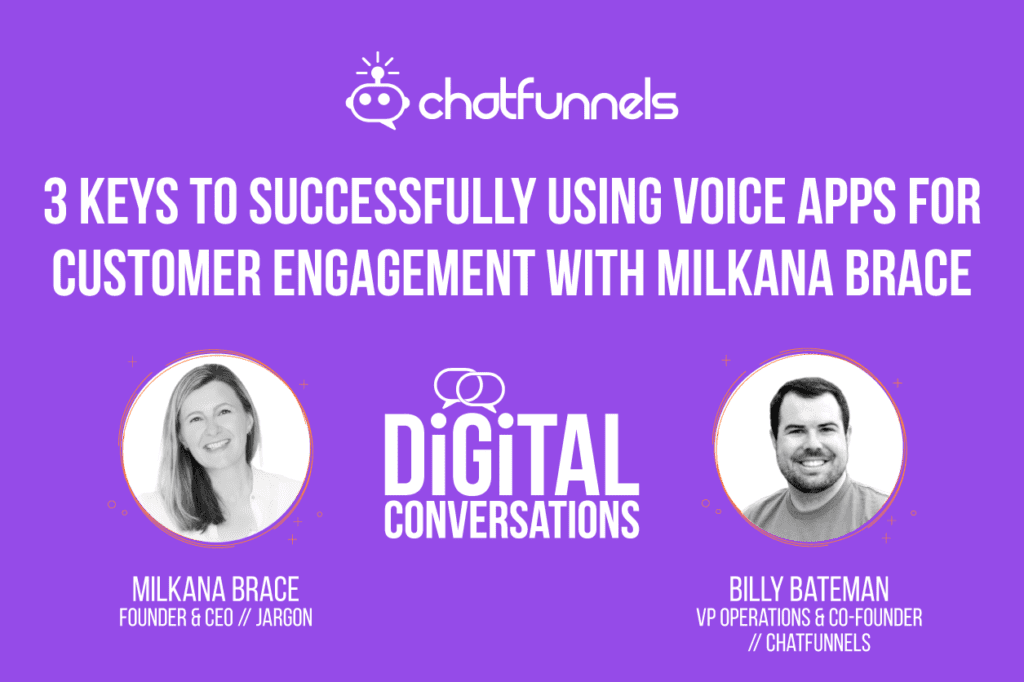
Reading Time: 20 minutes
Overview
In this episode of Digital Conversations with Billy Bateman,we are featuring Milkana Brace CEO and founder of Jargon. She defines helpful use cases of voice applications, creating multimodal applications and examples of voice skills that solve customers problems.
Guest: Milkana Brace- Founder and CEO of Jargon. Led global product and engineering teams as a Senior Director at Expedia and Groupon. Extensive experience with v1 products, high growth e-/m-commerce, and voice applications. Holds a track record of building high-performing teams.
Listening Platforms:
Transcript
Billy: All right everyone, welcome to the show today, I am your host Billy Bateman. Today my guest is Milkana Brace, CEO and co-founder of Jargon. Milkana thank you for joining us.
Milkana: Hi Billy thank you for having me.
Milkana’s Background
Billy: We’re really excited! So before we get into to everything, I like to have everyone just tell us something unique about yourself and I think an interesting way to do that since you know a lot of us you know we we’re on social media and a lot of our lives are there, if we were going to look Milkana up on social media and try to figure out you know who you are, what you are like, what you’re into, what’s something we wouldn’t know about you?
Milkana: You know maybe I would say that two things that come to mind maybe one thing that’s not obviously apparent is that I’m a two-time immigrant, I grew up in Bulgaria, as a teenager I moved to Montreal Canada and in my early 20s I moved to the States it’s not something that I talk about on a regular basis so it may not be apparent but obviously those experiences have really defined Who I am and something that’s even less obvious probably is that I have an amazing knack for finding four-leaf clovers, I most have found over 10,000 of those during my life it’s really insane I don’t know why it’s like the most useless skill to have in life but every day when I walk my dogs I find four-leaf clovers there we go, so I consider myself incredibly lucky.
Billy: Wow that’s interesting, so if somebody was interested in finding a 4-leaf clover obviously like you’ve got some type of gift but do you have a tip for anyone you know where do they start?
Milkana: I have no tip whatsoever, I don’t know it just it’s always been the case ever since I was I was very young yeah I would just see them I don’t know so I look for patterns I guess and I see I see those visual patterns of the four-leaf clover
Billy: Awesome cool
Milkana: Random fact
Introduction to Jargon
Billy: Awesome well that’s interesting I like it, I like it. So, let’s get into the meat of the topic today. Before we get into it though like can you tell us just a little bit about yourself? Your background? And Jargon and what Jargon does?
Milkana: Yeah, absolutely so at Jargon we have built a set of tools that help teams build voice applications. So these are applications where voice is a pretty big component of the interaction. Either because the user says something to the app and then the app responds to it or because possibly the app speaks back to the user. People are probably familiar with Alexa and Google assistant, those smart speakers that obviously rely pretty heavily on voice. But there is an increasing number of devices and platforms that include voice as a way for users and apps to interact. So we provide the tools that teams building such applications needs to really create engaging experiences.
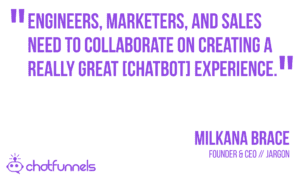
Billy: Awesome. Especially in an enterprise I can see how that’s a great tool where you’re going to have a lot of different people. That may have to even if they’re not creating the application at least sign off on it and say like I’m good with this.
Milkana: You are absolutely right Billy. I mean imagine what it takes to build a mobile experience or a web experience or even a chatbot experience right. We usually have a number of contributors. You have the designers who envision what the flow of the conversation might be. And you have even visual designers because often time the applications are really multimodal applications in that you have a visual component in addition to the voice component. And you obviously have the engineers often times you have marketing. You have sales. You may have legal involved and so all of those people need to collaborate on creating a really great experience. We provide them the tools to do that.
Billy: Awesome, awesome and so how did you guys. How’d you get started with Jargon like what’s the origin story?
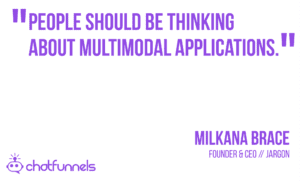
Milkana: Yeah you know I wish I could say it was one morning when I woke up and I had this brilliant idea that’s not how it went. It was really, it has really been a journey but my co-founder Jonathan. Jonathan Burstein and I started Jargon in December of 2017 and we kind of had an original idea which has absolutely nothing to do with the industry we’re in today. Started experimenting with that and other ideas and iterating and you know hitting dead ends. Trying out new ideas as is often the case in early-stage of product startups.
We were very fortunate that in the summer in the July timeframe of 2018 we got accepted in the elect’s accelerator it is a TechStars amazon partnership. That really helps early stage companies get off the ground. And as we were going through that accelerator, we really gained appreciation for this massive shift that’s happening in voice technologies. Of course the incredibly rapid consumer adoption that we’re witnessing. So we started digging into that space and really talking to teams to understand what are the tools that they need. What are the problems they’re experiencing. And that’s kind of how the product came to be really from getting a lot of input from various teams that are building voice applications.
Billy: Awesome, I mean we’ve taken a lot of twists and turns in our journey at chat funnels as well. like we’re not where we thought we were going to be but we’re in a good spot, so it’s interesting how things change and I love it.
Milkana: Absolutely and I think some of that is the function of you know the industries we are in are so rapidly changing and evolving. So you kind of have to respond to that and be ahead of it. So that’s part of it and then also part of it is as a young company. You’re still figuring out like what’s my place in the world and how do I make a difference. So, it’s both of those things happening in tandem.
The Industry
Billy: Oh yeah, oh yeah so I mean let’s hop into a little bit on the industry then. That’s where do you see like voice we’re in the chat bot space and it’s a little more mature. A little more adoption there but we’re still figuring it out lots of new things everyday. That’s going on but with voice, where do you see things going because it’s becoming a lot more common to interact with voice applications but I feel like it’s still got a long ways to go in a lot of ways.
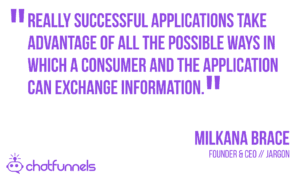
Milkana: Yeah, I agree with all of the statements you made. Voices becoming more and more commonplace but there’s still a long way to go. I think one of the most exciting aspects of voice is that it is so natural or at least it has the potential to be so natural right. We as human beings are so used to conversing, talking, listening, having an interactive engagement. And the promise of voice technologies is that we can create those experiences between consumers and the products.
That they interact with or the companies they interact with in a way where really it’s the consumer. That’s in the driver’s seat of the conversation. They can take the conversation and would whichever direction they want as opposed to being forced to follow a predetermined path of a mobile app or a website. Which is really how we’ve operated thus far that’s far less natural right.
So I think voice has tremendous potential. And I mentioned the concept of multimodal earlier in the conversation. I think that’s an important point to highlight. Which is voice is one way of interacting but we think that really successful applications take advantage of all the possible ways. In which a consumer and the application can exchange information. So that may involve a visual. That may involve video. That may involve static text and of course a voice component.
I think what will be really important is to figure out what is the context in. Which the user is interacting with the application. Are they in the privacy of their home. And are they in a public space. Are they in a work space and what is the appropriate response from the app. Should the app be verbalizing the response. Should it say something quick and then add more supporting visual information on the screen. What’s the right mix of interfaces to really provide the most optimal experience for the user.
Billy: Yeah, that’s interesting the context because I think most of the voice applications right now. Do a lot of them take context into account. Whether I’m like at home on my Alexa or in my car or even in a public place?
Milkana: You know I would say most applications do not take that into account directly. One of the things that we are doing at Jargon is to enable applications to have different responses based on where the user is. What device they are using so it’s really taking in all of the inputs we have about the context of the user. Not only who they are whether they like you know whether they have a preference for more let’s say more detailed responses or just high-level responses. Not only who they are and their personal preferences but also the context in which they are in.

Just to give you an example if you are interacting with your smart speaker in your car. You want to learn about the latest news maybe there is a video there. But you don’t want to be watching the video while you’re driving. That’s really distracting that would be dangerous for you and it would be dangerous for everyone else on the road.
So you probably just want to hear the kind of text-to-speech component. Or any pre-recorded audio that may come with the news segment. But if you were interacting with that exact same app and that exact same news media at home. Maybe in addition to the audio you actually want to see the actual video of the event. So those kinds of decisions dynamically figuring out what to show you given the context you’re in. Take some intelligence and those are some of the tools that we’ve built.
Billy: Awesome, that’s awesome. Most of them I feel like it’s like the same experience whether you’re at home. Whether you’re in the car or you know if you had it in your office. I’m not going to give personal information out why I’m at the office. But if I’m in my car sure like it’s probably just me you know so that’s great.
Milkana: But if you are checking your balance in your bank account you don’t want the app to be saying that out. If you are on a bus like going to do some work or some personal errands while you on the bus. So, there are lots of situations to where either you as the user or the app in its response may choose one interface versus another.
Applications for Consumer Packaged Goods Brands
Billy: Yeah, awesome so I want to dig in like you know we focus on sales and marketing and using bots. Email any way that we’re interacting digitally with our customers or prospects. So how are people using voice to help drive you know their marketing and their sales efforts?
Milkana: Well I think there’s a lot of experimentation happening in that space. It’s really exciting to see we are probably further along in the consumer space. And we are in the enterprise space but I’ll touch upon both real-quick. So some of the CPG like the consumer package goods companies have really taken advantage of voice applications. In kind of in a marketing capacity to reach consumers in a new way and in this new channel. Uncrowded channel which is voice and in a much more just a more innovative way.
What’s really interesting over the last few months with the pandemic is that of course people are spending more time at home. They’re working from home and what has showed up in the house in the past few years. It’s the smart speaker. So all of a sudden you can reach consumers who are no longer in the streets. And the malls kind of you know in physical retail stores. They’re in their home you can reach them in the comfort of their home and really educate them on your product or market your product.
So that’s been an interesting shift just to give you an example earlier this year pre-pandemic. But you know coke for example had an Alexa campaign. And they even advertised that during the Superbowl where you could order like a coke energy drink through Alexa. That was a way to kind of promote the coke brand and create awareness.
Other products that come to mind tied has a very popular Alexa skill. You can ask it how to remove any stain maybe an ink stain or wine stain or a blood stain whatever the case might be. It has very helpful instructions. But it really ultimately it’s a new way to engage with the audience. Nutella has a relatively new skill. You can ask Alexa to open Nutella creations and you’ll get all sorts of recipes.
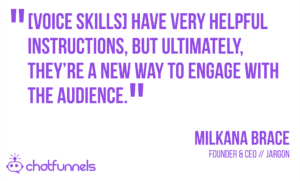
So, lots of other examples in the consumer space. In the enterprise space we actually seeing a shift. Which is really quite interesting in that more and more non Alexan Google assistants are coming online. So probably the most interesting and relevant example here is Salesforce Einstein assistant. Which is really you know it has more than a voice component but now increasingly a voice component.
Salesforce have posted a bunch of demos of how they envision this assistant to be but really is being able to reach. Being able to engage with your accounts be it kind of in the sales or marketing capacity through voice. So you might be driving to meet a client and then on your way to the client you can get quick information on the account. And really be able to be up to date as you walk into the meeting
Billy: Oh, that’s interesting with Salesforce using Einstein to do that. I mean we use Salesforce and I didn’t even know we could do that.
Milkana: I think some of it is still in development but it’s certainly very exciting the vision that they have shared.
Billy: Yeah, I love the examples you gave with the consumer brands because they’re always ahead of us in the b2b world on what we should be doing, I mean rarely do I think b2b marketers think of something as tactic or a strategy. And do it before the b2c guys have gotten to it. but I love the idea of like with Tide and Nutella. They’re simply helping you to use their products more rather than like hey let me order you some more tide. Or tell you why you should buy tide you already know.
Milkana: Isn’t that a marketer’s dream to be a helpful assistant to your customers when they need you. Right when they need you in the comfort of their home you know be able to provide information to them, I mean it’s just such an amazing opportunity.
Billy: Yeah, it is and I mean I think the b2b world will pick up on how we can also be that helpful assistant over voice. That seems like something you can do whether it’s like okay like the Einstein example. Tell me about this account. Who’s on the account, when was the last interaction with them. What’s the deal look like all of that but there’s got to be other ways even through the Alexa in the Google home.
Voice Applications Wrap-up
Billy: So let me let me ask you this then. What should marketers be thinking about even if they’re you know they’re small company. A big company they want to be on the cutting edge in voice or something. Maybe their boss is talking about maybe the CEO like what can we do here. They don’t know what to do like it’s brand new. What are just some ideas as marketers we should be thinking about in ways to utilize voice?
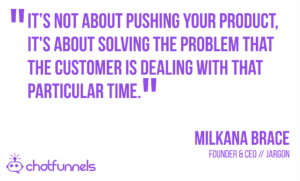
Milkana: Yeah, I mean I think the best piece of advice I can share is think about your consumer. And think about it from their perspective. Think about them being at home. And think about them being on the go. Think about them being in a public space or at work and having access to voice and wanting to converse for the lack of a better word with your product or your company. And what would that experience be like?
And I think this is where marketers really need to use imagination, just like with the Tide example it’s not about pushing Tide or talking about all the ingredients of Tide or whatever the case might be or how many loads you can get out of the box, it’s about solving the problem that the customer is dealing with that particular time. So I think again putting yourself in the shoes of your customers. The problems they’re trying to solve. And being helpful to them at that point is probably the best way to engage through these new emerging very contextual voice driven experiences.
Billy: Awesome, so think about the location where your customer is and then how you can be helpful to them in that situation. Yeah it makes sense. So okay Milkana is there anything that I should have asked you that I haven’t. And you are like if Billy was really smart, he would have asked me about this. Because I have awesome things to say?
Milkana: I’m thinking you asked a lot of good questions and of course we can spend hours and hours and hours talking about this emerging industry right
Billy: We could
Milkana: But I think probably some of the summary points are that people should be thinking about multimodal applications, so it’s not just moist it’s not just Alexa and Google. There is an increasing number of new assistants that are showing up every day that’s something for people to be educated about. And know about and that you know the user experience can be reinvented. Reimagined given this new interface.
So I really hope a lot of your listeners will find inspiration that there is a new way for them to reach their customers. And we’ll think about creative ways of applying voice. If you are interested in talking, they can reach me at milkanajargon.com. I would be happy to tell them what we’ve learned working in the industry and also what tools we offer for teams that are building voice applications.
Billy: Okay, sounds good thank you so much Milkana it’s been enlightening and best of luck with Jargon.
Milkana: Thank you so much Billy
Billy: Okay, we’ll chat later
Milkana: Bye

